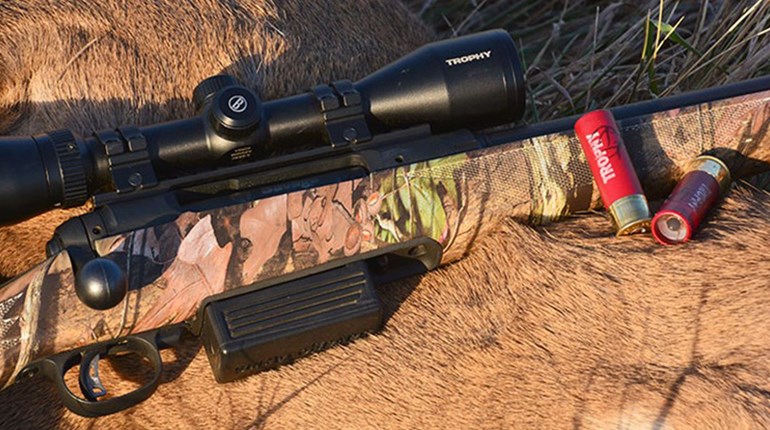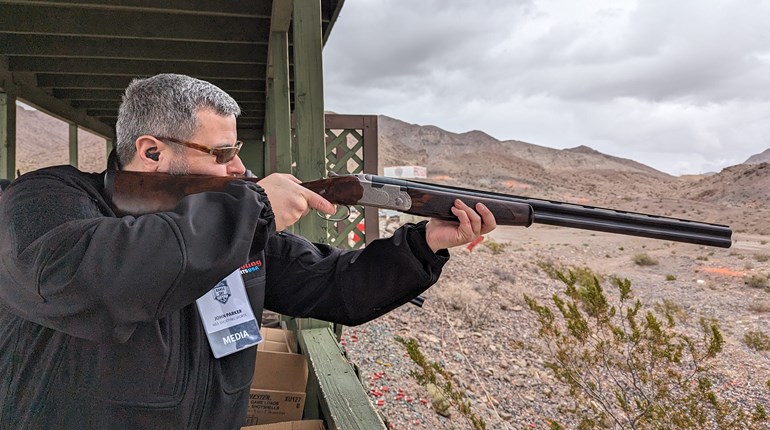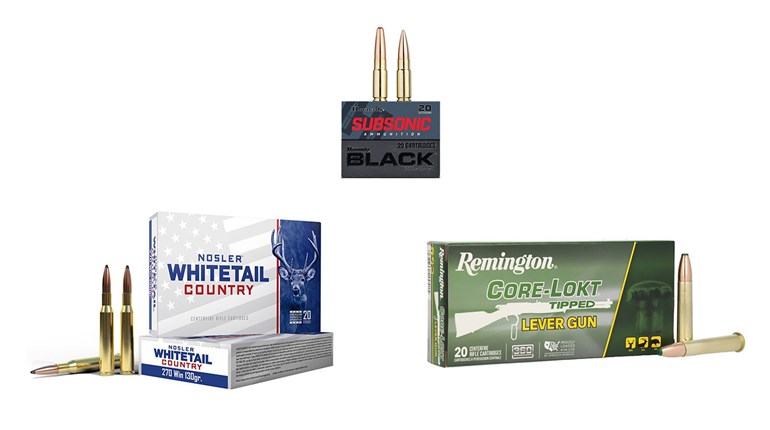
It’s a choice every hunter dreads, yet still hopes he will encounter someday.
I had been watching a huge buck for two days in a row. His antlers were an unusually bright white and so big he looked like something out of a Dr. Seuss book.
I had seen him twice the morning before; both times he was out of range. This morning, as the sun lit up south-central Iowa, he was feeding out in a bean field 360 yards from my stand, much too far for my firearm. Within a few minutes of light’s arrival, he drifted off into the woods. But, now there was another buck in the cornfield to my right, in range and coming closer. He was big, not a match for the white-horned buck, but big.
He was also available.
So far it had not been my best year of deer hunting. I tried, but it seemed like the world was aligned against me. A couple of early hunts were just unmitigated disasters and ended with no shots fired. My home state, Vermont, had experienced one of the snowiest winters on record and the winter kill was worse than anybody imagined. It was like an alien spaceship had run a giant vacuum cleaner around the woods and sucked up most of the deer. There were very few tracks and droppings and the mast crop lay rotting and uneaten on the ground. Still, I managed to locate the biggest buck I have seen in 45 years of hunting in Vermont. He came from a direction I didn’t expect and I had to climb a few feet up a steep bank and poke my rifle through some brush and over a blowdown. It was an amateur mistake, one I should never have made; my scope cleared the blowdown while my bullet did not. It clipped the top of the log and sailed off to that place where misbehaving bullets go to die.
That shot still keeps me up at night.
So here I was, late in the year and venison-free. I was hunting with my good friend Mike Mattly, who is the PR director for Pradco, on his farm in Iowa. Faithful readers may remember “The Bully Buck” I wrote about in American Hunter a couple years ago. I shot him in the last hours of the last day in the most brutal cold and wind I have ever experienced while deer hunting. I could see the hay bale I used to block the wind that day, just 50 yards from my current stand. I shot another very nice 9-point buck less than 200 yards from here a few years before that. His photo and story also graced these pages. This ground had been generous to me but I wondered if it was trying to send a message.
I turned to look again at the buck feeding in my direction. As the morning light grew stronger, I was beginning to see more detail as he moved through the brown, standing corn that filled the steep hillside and his dark antlers appeared to grow larger. I watched him and thought about that white-horned giant. Then I said out loud, “Go away before I shoot you!”
But not loud enough for him to hear. I am not completely insane. Still, as if he heard, he disappeared for a while and I breathed a sigh of relief. The irony of experiencing relief when a world-class buck walks off didn’t occur to me until later.
Well, perhaps irony is not as good a word as stupidity, particularly considering the tough year I was having.
When he reappeared the light was much better and he had grown considerably larger antlers. Must’ve been the corn diet.
Through the clear lenses of my Swarovski binocular I could see that he was a true 12-point buck. While the front point on each side was broken off, the bases remained. In all my years of hunting whitetails just about every place they live, and in shooting what is probably far more than my fair share, I had never shot a true 12-point, main-frame, whitetail buck. I have lots of 10s with an extra couple of points, but a clean, typical 12-point has eluded me and I was a bit obsessed with finding one. Of course the deer hunting gods exposed their usual cruelty with the broken tines, but I could live with that.
I made a decision: This was the buck I truly wanted. I took my eyes off him for a moment to reach behind me for my gun and when I looked back he had his head down feeding in the cornfield about 75 yards away. Just before the final slack came out of the trigger I realized something was wrong, so I waited. When he picked up his head, the buck morphed into a huge doe.
Twenty minutes ago I was telling him to run away, now I was trying not to lose my breakfast out the blind’s window. The disappointment turned me numb. But, over the years of hunting I have learned that when you are not sure what to do, it’s best to do nothing. So I waited and watched.
Ten minutes later a cornstalk shook a little, even though there was no wind. I focused the binoc and could see an antler tine tapping it as the buck struggled with a cob he had pinned with his front feet. It took about three eons of waiting, but finally he abandoned that ear and moved into an open row. When his shoulder was covered by the crosshairs, I finished my interrupted date with the trigger.
In a lot of places deer hunters now have the choice I faced on this hunt. No, not the choice to shoot the really big buck in front of me or hold out for the really, really big buck that may or may not show up later, but the dilemma of using a shotgun or muzzleloader.
In all the years I have hunted in south-central Iowa, this buck was a game-changer. Until then I had shot all my deer there with a muzzleloader. The wide 12-point fell to a Benelli and the new Federal Trophy Copper 12-gauge slug. In fact, I was using engineering samples from Federal and it was one of the first deer ever taken with that new slug.
Which Gun?
So, how do you choose between a shotgun or muzzleloader? Which is the best option? There are pros and cons to each. The most obvious: A shotgun carries more than one shot so it’s very fast on the reload. In fact, if you’re using a Benelli Super Black Eagle semi-auto like I was, the gun will be ready for the next shot in about .15 second. I have gotten pretty good at reloading a muzzleloader over the years, but I am not that fast.
Compared to a muzzleloader, a shotgun does not have to be cleaned every time you shoot it or risk corrosion destroying the firearm. That’s a big plus for anybody but a masochist with a gun-cleaning fetish. Shotguns are much more reliable in wet weather than a muzzleloader. If you have not experienced the frustration and rage of a muzzleloader failing to fire at a deer while hunting in the rain, well then I’ll wager you have not hunted with them much. Trust me, it will happen, sooner or later it gets everybody.
Accuracy—
I picked at random 30, three-shot, 100-yard groups from slugs and slug guns I have tested for the NRA over the past few years. I included all the popular, top-of-the-line, 12-gauge sabot slugs and several different shotguns. I came up with an average 100-yard, three-shot group size of 2.54 inches.
I looked at an equal number of three-shot, 100-yard muzzleloader groups with several rifles. These included a multitude of different rifles, bullets, propellants and propellant charges. The average for those groups is 2.24 inches. With a difference of only .3 inch that’s pretty much a dead heat. To be honest I was surprised. I thought the muzzleloader would kick the shotgun’s butt in accuracy, but the numbers don’t lie.
Of course, a shooter can choose an accurate firearm and then experiment with different loads or ammo until he finds the one that is the most accurate and probably cut those numbers significantly. But that would tell us nothing. This is a relatively large sample picked at random and it says the muzzleloader has a slight advantage in accuracy, but very slight.
Shotgun slugs have changed and evolved over the past few decades so that the modern sabot slug is now very similar to the modern sabot muzzleloader bullet. The new Federal 300-grain Trophy Copper shotgun slug is an expanding, solid copper bullet with a polymer tip and represents the leading edge of slug technology. Jessica Stevens at Barnes Bullets tells me that their bestselling muzzleloader bullet is the 250-grain Spitfire T-EZ. So, let’s look at the external and terminal ballistics of these two for comparison.
Velocity—
The 3-inch version of the Trophy Copper slug has a muzzle velocity (MV) of 2000 fps. With three 50-grain Pyrodex pellets the Barnes 250-grain bullet has an MV of 2197 fps. The slug has 1451 fps remaining at 150 yards and 1305 fps at 200 yards. The muzzleloader, which started with almost 200 fps more than the slug, has 1628 fps remaining at 150 yards and 1467 fps at 200 yards. Slight advantage for the muzzleloader.
Bullet Path—
With a 100-yard zero the slug is 3.93 inches below the line of sight at 150 yards and 11.99 inches low at 200 yards. The muzzleloader bullet fares a little better. It’s 3.02 inches below the line of sight at 150 and 9.33 at 200 yards. So, in bullet path, the muzzleloader retains a very slight edge over the slug gun. This is due primarily to the higher velocities.
Energy—
The slug has 2,665 ft.-lbs. at the muzzle; 1,744 ft.-lbs. at 100 yards; 1,404 at 150 yards; and 1,135 at 200 yards. The muzzleloader has 2,680 ft.-lbs. at the muzzle; 1,806 ft.-lbs. at 100 yards; 1,472 at 150 yards; and 1,195 at 200 yards. While both retain enough energy to reliably kill a whitetail out to 200 yards, the muzzleloader does have a very slight advantage in energy over the slug—again due to the higher velocities, as energy is tied exponentially to velocity.
Study External Ballistics
Thanks to external ballistics, the muzzleloader gains a slight edge over the shotgun, but much less than most hunters believe.
Once we go past 200 yards with either of these modern firearms, things start changing very fast. The acceleration of gravity causes the bullet to drop faster and faster as the range increases. The drop below the line of sight for the first 200 yards is more than doubled in the next 50 yards. In other words, relative to line of sight, the bullets drop more from 200 to 250 yards than they did from zero to 200 yards. It just gets worse from there. At 300 yards, the drop is nearly four times as much as it was at 200 yards. Also, by 250 yards both bullets have fallen below the 1,000 ft.-lb. threshold that conventional wisdom holds is the minimum for whitetail deer.
The bottom line is ballistics don’t lie, and they state that for any ethical hunter, 200 yards is about the limit of performance for a modern slug gun or modern muzzleloader. I know that’s not what a lot of hunters believe or have been told, but the facts are the facts. Consistently putting a bullet in the kill zone on a whitetail with either of these guns past 200 yards is going to exceed the abilities of the vast majority of hunters. Once we get a little beyond that, it will exceed the limits of the guns.
The rate of bullet drop is rising exponentially so that even a minor error in range calculation can be critical. The farther the distance to the target, the faster the bullet is dropping so the problem is compounded with every yard of distance added.
Say we have a 6-inch kill zone, which is typical for shooting deer. That means 3 inches in any direction can put you out of the zone. Three inches is how much the shotgun slug drops between 250 and 259 yards. (The muzzleloader is a little better; it takes 18 additional yards past 250 to drop 3 more inches—again, due to the extra velocity from the three-pellet load and lighter bullet.)
So with the shotgun a miscalculation of less than 10 yards can cause you to wound or miss, even if everything else is perfect. But, perfection is impossible. By now the accuracy potential of the guns is starting to grow so large that under field conditions it will be mathematically impossible to ensure a kill zone hit 100 percent of the time. The 2.54-inch group size at 100 yards increases to 6.35 inches at 250 yards, larger than the kill zone. Discounting wind and human error, a 10-yard miscalculation and the simple accuracy of the gun can put the impact off more than 7 inches.
With a mild 10 mph wind the slug has drifted more than 21 inches at 250 yards. A 15 mph wind, just 5 mph more, adds 10.6 inches to that. Can you judge the wind with that kind of precision? I know I can’t. Is it 10 mph or 15 mph? Is it a perfect 90-degree angle or is it more like 45 degrees? Is the wind the same velocity and direction all the way to the target?
If the bullet drifts 32 inches at 90 degrees, how much will it drift if the wind is at 45 degrees? (The answer is 15.2 inches, but I had to go to a computer to figure that out.) So, do you hold 21 inches to the wind or 32 inches or 15 inches? Or maybe you are just trying to shoot too far in this wind?
Even without the wind, it all just falls apart past 200 yards. Use your hunting skill; get closer. That’s the concept of a shotgun or muzzleloader anyway.
Terminal ballistics—what happens after the bullet hits the deer—are much tougher to evaluate. The slug measures .500 inch, which is slightly larger than a muzzleloader bullet at .451 inch, which means the slug has a slightly larger frontal diameter. With a non-expanding bullet the difference might matter. But, they are both expanding bullets. That means the bullet design and impact velocity will control the final frontal diameter. They both expand to a large diameter. This is important for two reasons. One is that with the relatively low velocity of a muzzleloader or shotgun the bullets rely on penetration and frontal diameter to cause tissue damage. The bullet must have enough energy stored to push it through the game in its expanded form. I have shot a lot of deer with monolithic, expanding slugs and muzzleloader bullets. It is rare to recover either from a dead deer. When I do, it is usually from a finishing shot when the deer is down or with an end-to-end frontal shot. With most broadside shots the bullet will exit. So, I can’t see that there is an advantage one way or the other with either of these in deer hunting. Of course, we are looking at only a small representation of the types of muzzleloader bullets or slugs that are on the market. A lead-core, thin-jacket bullet or slug might not exit. However, a total comparison of the terminal ballistics is for another article. For now, I think it’s safe to say that with similar style projectiles, the two are just about dead even for terminal ballistics while hunting whitetails.
I had thought that a clear winner would emerge here, but that’s not the case. I think it boils down to your hunting style, the firearms that interest you most and which one you trust. As a gun guy who loves to experiment, I see that as a half-full glass. On my hunt I can pick a shotgun or muzzleloader with the full confidence that either one is well suited for hunting big whitetail bucks.



































